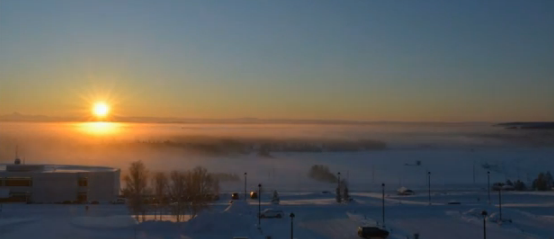Winter solstice in Fairbanks, Alaska – December 21, 2012

Time-lapse movie of the winter solstice sun and ice fog in Fairbanks, Alaska on December 21, 2012.
Video by Taro Nakai, Micrometeorologist — a researcher of micrometeorology (dynamics of the interaction between plants and atmosphere). Postdoctoral fellow of International Arctic Research Center, University of Alaska Fairbanks.
The December solstice occurs when the sun reaches its most southerly declination of -23.5 degrees. In other words, it is when the North Pole is tilted 23.5 degrees away from the sun. Depending on the Gregorian calendar, the December solstice occurs annually on a day between December 20 and December 23. On this date, all places above a latitude of 66.5 degrees north (Arctic Polar Circle) are now in darkness, while locations below a latitude of 66.5 degrees south (Antarctic Polar Circle) receive 24 hours of daylight.
The axial tilt of Earth and gyroscopic effects of the planet’s daily rotation keep the axis of rotation pointed at the same point in the sky. As the Earth follows its orbit around the Sun, the same hemisphere that faced away from the Sun, experiencing winter, will, in half a year, face towards the Sun and experience summer. Since the two hemispheres face opposite directions along the planetary pole, as one polar hemisphere experiences winter, the other experiences summer.
More evident from high latitudes, a hemisphere’s winter solstice occurs on the shortest day and longest night of the year, when the sun’s daily maximum elevation in the sky is the lowest. Since the winter solstice lasts only a moment in time, other terms are often used for the day on which it occurs, such as “midwinter”, “the longest night”, “the shortest day” or “the first day of winter”. The seasonal significance of the winter solstice is in the reversal of the gradual lengthening of nights and shortening of days.
Worldwide, interpretation of the event has varied from culture to culture, but most Northern Hemisphere cultures have held a recognition of rebirth, involving holidays, festivals, gatherings, rituals or other celebrations around that time.

Commenting rules and guidelines
We value the thoughts and opinions of our readers and welcome healthy discussions on our website. In order to maintain a respectful and positive community, we ask that all commenters follow these rules.